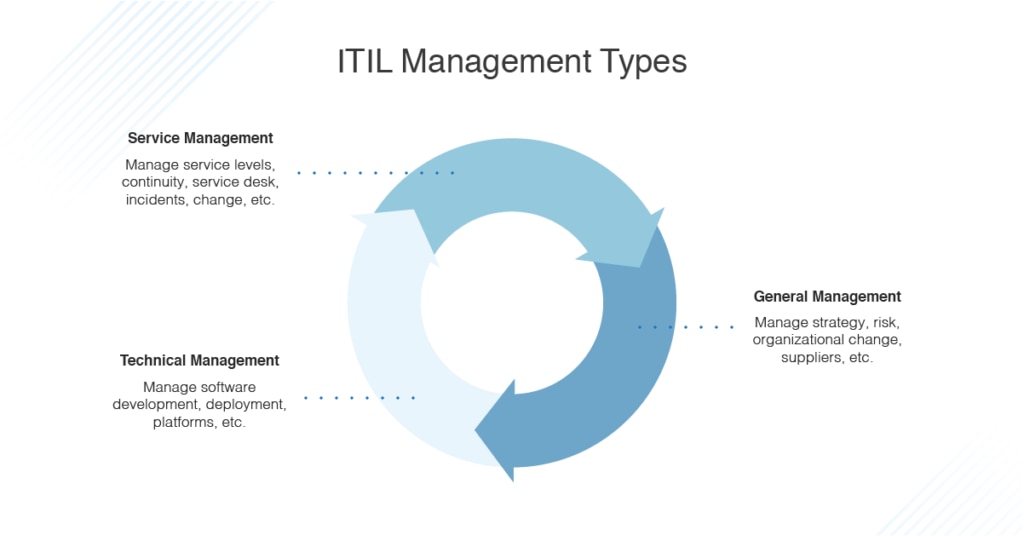ITIL, or Information Technology Infrastructure Library, is a framework designed to help organizations effectively manage IT services. It consists of best practices and processes that enable companies to align IT operations with strategic goals and deliver superior services to customers. Read what ITIL is and how it enables organizations to improve IT service management practices.
What is ITIL?
Information Technology Infrastructure Library, also known as ITIL, is a framework of best practices that helps to deliver high-quality IT services. The approach ITIL takes is intended to combine processes, people, and technology to support service delivery, evolution, and maintenance for end users or customers.
Business success can depend significantly on the stability, agility, and integration of the IT components and their services. If networks, databases or servers go down, or if incidents aren’t remedied or risks not managed, this can have major impacts not just on the business internally, but on all services and end users. If an organization can more efficiently deliver their services to customers, with greater reliability, they have a much higher chance of success.
With customer needs and technologies rapidly changing in today’s world, it’s vital to have a set of practices in place to help your business to adapt quickly. This is where ITIL comes in, as its practices can offer flexibility, innovation, and added value to services in a simple and customer-focused way. ITIL can help ensure your IT process standards contribute effectively to your overall business strategy.
ITIL Meaning
ITIL Processes
What Do ITIL Process Standards Mean in Practice?
Tools for Implementing ITIL
Getting Started With ITIL Processes
ITIL Meaning
So, what is ITIL exactly? Essentially, ITIL is a guide or framework to facilitate the delivery and management of IT services. Some people view it as ITIL standards, but really, it’s a set of best practices included in five guidance publications, and it evolves over time in response to changes in the way IT organizations operate. Each of the five publications covers different parts and stages of the IT service lifecycle.
This framework was initially developed by the Central Computer and Telecommunications Agency (CCTA) in the UK in the ‘80s. It was viewed in the first instance as a set of standards for improving IT performance and was later aligned with the international ISO/IEC 20000 Service Management standard. ITIL has been owned since 2013 by the UK Cabinet Office and Capita in a joint venture called Axelos, and Axelos controls and grants licensing permissions to those who want to use the ITIL framework. If a business wants to use ITIL internally only, they don’t need to request a license. It’s now viewed less as a set of standards and more as a framework of best practices or processes.
ITIL can also be contrasted with IT Service Management (ITSM), but these are two fundamentally different things. ITSM is how enterprises and businesses create, design, deliver, manage, and support IT services, while ITIL is a best-practice framework for how IT services should be managed within the organization. ITIL is essentially intended to help ITSM processes be integrated into the enterprise’s overall business strategy.
ITIL Processes
The next question is: what is ITIL, when it comes to process? Older versions of ITIL described a set of processes to be followed when implementing ITIL, but the newest version has instead included 34 practices inside the ITIL service value system (SVS). The Service Value System is defined by Axelos as “How all the components and activities of the organization work together as a system to enable value creation.”
They also note, “Each organization’s SVS has interfaces with other organizations, forming an ecosystem that can, in turn, facilitate value for those organizations, their customers, and other stakeholders.”
ITIL is intended to embody a set of principles—including value, transparency, collaboration, simplicity, holistic approaches, and a focus on user experience. Effectively, IT processes and designs are supposed to be better integrated into the entire business structure and needs, rather than a separate silo in which IT teams work alone without a coherent role in business needs and visions.
The SVS contains five core components:
- ITIL Service Value Chain
- ITIL Practices
- ITIL Guiding Principles
- Governance
- Continual Improvement
The set of ITIL practices is split into three different kinds: general management practices, service management practices, and technical management practices. All these practices also fall under the six parts of the ITIL value chain. These six parts are:
- Plan
- Improve
- Engage
- Design and Transition
- Obtain/Build
- Deliver and Support
The previous versions of ITIL included “4 P’s of Service Design”: People, Products, Partners, and Processes. The newest version of ITIL instead uses four dimensions to encompass these ideas, as well as to link to the ITIL practices and the value chain: Organizations and People; Information and Technology; Partners and Suppliers; and Value Streams and Processes. 
© 2022 SolarWinds Worldwide, LLC. All rights reserved.
General Management Practices
- Strategy management
- Portfolio management
- Architecture management
- Service financial management
- Workforce and talent management
- Continual improvement
- Measurement and reporting
- Risk management
- Information security management
- Knowledge management
- Organizational change management
- Project management
- Relationship management
- Supplier management
Service Management Practices
- Business analysis
- Service catalog management
- Service design
- Service level management
- Availability management
- Capacity and performance management
- Service continuity management
- Monitoring and event management
- Service desk
- Incident management
- Service request management
- Problem management
- Release management
- Change enablement
- Service validation and testing
- Service configuration management
- IT asset management
Technical Management Practices
- Deployment management
- Infrastructure and platform management
- Software development and management
These practices are intended to help both the IT team and service delivery, as well as to have impacts on business efficiency and processes. For instance, by organizing your enterprise IT services using an ITIL framework, you can increase the efficiency and productivity of your IT team by separating out different management tasks, responsibilities, tools, and roles.
You can also follow established guidelines for managing issues, processes, or troubleshooting, which can help issues be resolved faster and changes be managed more easily. For the business itself, IT issues and incidents will have a reduced impact, due to better management and resolution. All these benefits can lead to better stability, service levels, and productivity.
In addition, ITIL practices can help with more flexible service delivery and faster shifts between existing practices and new technologies. The ideal outcome of this is streamlined and improved service delivery, and customer satisfaction goes up as a result. A beneficial secondary effect is with resource and process streamlining, cost reductions may result. The final positive effect is with greater insight into IT processes and services, business risks can be seen more easily, which allows you to put measures in place to prevent service disruptions or shutdowns. Back to top
What Do ITIL Process Standards Mean in Practice?
If you want to implement ITIL in your business, first you need to gain a solid understanding of the above practices and then gain business buy-in.
For ITIL practices there are a lot of consulting, training, and certification services you can use to help your teams have a greater and more coherent understanding of what ITIL is, and how to apply it in everyday business processes. There are five levels of ITIL in ITIL 3:
- Foundation level
- Practitioner level
- Intermediate level
- Expert level
- Master level
These have now been streamlined in ITIL 4 into ITIL Foundation and ITIL Master, with two separate paths in the ITIL Foundation course: ITIL Managing Professional (MP) or ITIL Strategic Leader (SL). The MP exam is for IT professionals working in technology and digital teams who work throughout their organization, rather than in an IT department alone. This is best for people who need to manage and run IT projects, workflows, and interdisciplinary teams.
The ITIL SL approach is more suited for individuals who are working in “all digitally-enabled services,” rather than those people who are in IT operations. For example, this might be someone working in digital strategy or with a high level of contact with people in IT teams. The focus is on the interaction between business strategy and technology, and how IT teams and services work together with business processes. Both the SL and the MP pathway in the new setup can lead towards the ITIL Master exam, which remains the highest certification you can get in ITIL 4.
With the increasing prevalence of big data and cloud strategies, having a clear and coherent approach to data and risk management, as well as event management and reporting, is vital for ensuring your services can be effective and reliable even through large transformations.
Tools for Implementing ITIL
When you’re trying to apply ITIL processes or frameworks in your business, you need tools to help you implement the different management practices.
For example, a tool like Web Help Desk or SolarWinds Service Desk can help you implement practices related to service management in particular. These are great tools for incident management, problem management, a service desk setup, managing service request, and more. These excellent SolarWinds tools include features such as automated ticket management, so IT staff can streamline ticket assignment and escalation. They can also set up SLA expectations and let you know when you have an SLA deadline approaching, which helps you meet your customer’s expectations.
Finally, among other features, Service Desk includes a customer satisfaction feedback tool, so after each service request you can find out whether you could have done a better job or improved delivery. With Web Help Desk and Service Desk, you get important management tools for change management, service delivery, and asset management, and much more. These platforms can even provide alerts and reports for additional visibility, which is a crucial element for ITIL best practices.
Getting Started With ITIL Processes
ITIL is an extremely useful framework for helping you understand and organize your approaches to business IT management. It combines the capabilities of your IT team with the needs of your customers, business practices, and structures, while keeping the ideal of high-quality service delivery at the core.
By using appropriate supporting tools, you can easily implement and facilitate the framework ITIL provides, which can have huge and long-lasting positive effects on your business. Following ITIL practices with good software and IT tools to assist you can ensure your customers receive good-quality services and your IT teams and operations are highly integrated into your business processes.

